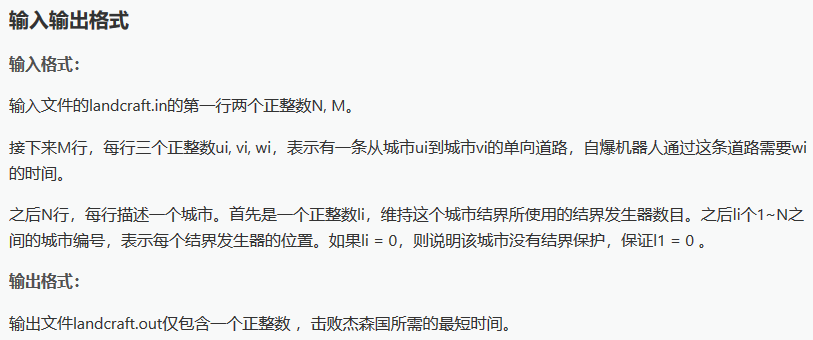题目链接:https://www.luogu.org/problemnew/show/P2446




最短路变形,用dis数组记录到达的最短路,用dis2数组记录可以通过的最短路
算是加强了对迪杰斯特拉算法的理解吧=-=之前一直用dis数组去更新新边,其实应该用struct里面的v来更新新边=-=wa了好多次...
代码:
#include<cstdio> #include<cstdlib> #include<vector> #include<cstring> #include<queue> using namespace std; const int N=70050; struct node{ int nu,v,ne; }edge[N*2]; struct node2{ int nu,v; bool operator<(const node2&other)const{ return v>other.v; } }; int head[N/20],dis[N/20],cnt[N/20],dis2[N/20]; bool vis[N/20]; int tot,n,m; vector<int>g[N/20]; void add(int a,int b,int c){ edge[++tot].nu=b; edge[tot].v=c; edge[tot].ne=head[a]; head[a]=tot; } void solve(){ priority_queue<node2>q; q.push((node2){1,0}); dis[1]=0; dis2[1]=0; while(!q.empty()){ node2 a=q.top(); q.pop(); if(vis[a.nu])continue; vis[a.nu]=true; for(int i=head[a.nu];i!=-1;i=edge[i].ne){ int k=edge[i].nu; if(dis[k]>a.v+edge[i].v){ dis[k]=a.v+edge[i].v; if(!cnt[k]) q.push((node2){k,max(dis[k],dis2[k])}); } } for(int i=0;i<g[a.nu].size();i++){ int p=g[a.nu][i]; cnt[p]--; dis2[p]=max(dis2[p],a.v); if(!cnt[p])q.push((node2){p,max(dis2[p],dis[p])}); } } } int main(){ scanf("%d%d",&n,&m); memset(head,-1,sizeof(head)); memset(dis,0x3f,sizeof(dis)); for(int i=1;i<=m;i++){ int a,b,c; scanf("%d%d%d",&a,&b,&c); if(a!=b) add(a,b,c); } for(int i=1;i<=n;i++){ scanf("%d",&cnt[i]); for(int j=1;j<=cnt[i];j++){ int a; scanf("%d",&a); g[a].push_back(i); } } solve(); printf("%d ",max(dis[n],dis2[n])); }